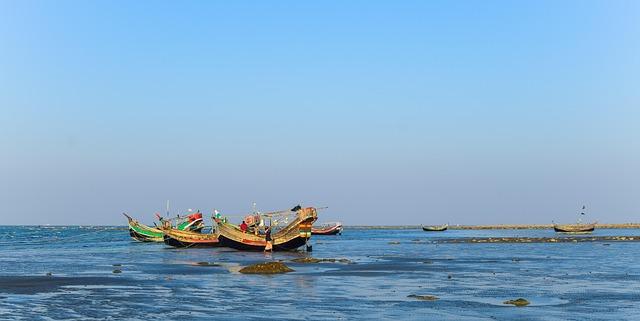Chittagong Seaport Moves Nine Notches Down in Global Rankings: A Cause for Concern
In a recent report that has sent ripples through the maritime and trade sectors, Chittagong Seaport, Bangladesh’s premier gateway for international trade, has plummeted nine places in global rankings, according to the latest findings by The Financial Express BD. This notable drop raises questions about the operational efficiency, infrastructural bottlenecks, and policy frameworks affecting one of the nation’s most critical economic lifelines.Positioned as a vital hub in South Asia’s shipping landscape, chittagong Seaport’s decline poses potential drawbacks not just for Bangladesh’s economy, but also for regional trade dynamics. In this article, we delve into the myriad factors contributing to this downturn, its implications for trade and commerce, and the urgent reforms needed to regain Chittagong Seaport’s competitive edge on the world stage.
Impact of Global Supply Chain Disruptions on Chittagong Seaport performance

The recent global supply chain disruptions have had a profound effect on the performance of the Chittagong Seaport,one of the key gateways for trade in Bangladesh. As international shipping routes faced delays and unpredictability due to factors such as the COVID-19 pandemic,geopolitical tensions,and the fallout from natural disasters,the seaport experienced a significant decline in its operational efficiency. This degradation is evidenced by the following factors:
increased Turnaround Time: Vessels are taking longer to load and unload due to cargo backlogs.
Container Congestion: Limited availability of empty containers has constrained export capabilities.
Rising Shipping Costs: Freight rates surged,impacting the overall cost of goods.
Moreover,the port’s ranking in global shipping indices deteriorated,with Chittagong falling 9 places in recent assessments. This decline is attributed not only to operational challenges but also to inadequate infrastructure and outdated logistics processes, which hinder the port’s ability to accommodate large-scale and efficient transactions. To put this into perspective, here’s a simplified comparison of port performance metrics:
Performance Indicator
Previous Year
current Year
Average Vessel Turnaround Time (hours)
36
55
Container Dwell Time (days)
7
12
Global Ranking
XYZ Rank
ABC Rank
Analysis of Key Factors Behind the Drop in Ranking

The recent decline in Chittagong seaport’s global ranking can be attributed to several interlinked factors that have raised concerns among stakeholders. Logistical inefficiencies remain a primary driver; with increasing congestion at the port exacerbated by inadequate infrastructure and a growing backlog of vessels awaiting berthing. These problems not only delay ship turnarounds but also inflate shipping costs, making Chittagong less competitive compared to other regional ports. Moreover, insufficient investment in technology and facilities has limited the port’s capacity to handle larger vessels, which is crucial in today’s shipping industry dominated by mega-ships.
In addition to operational challenges, the port’s administrative hurdles have played a significant role in hindering its performance. Many shipping lines have reported frustrations with regulatory bottlenecks, resulting in longer clearance times for cargo. Additionally, changes in trade patterns due to geopolitical shifts and evolving maritime laws may have diverted traffic away from Chittagong towards more agile ports. To exemplify the situation, consider the following table summarizing the key challenges:
Challenges
Impact
Logistical Inefficiencies
Increased congestion and delays
Insufficient Investment
Limited capacity for larger vessels
Administrative Hurdles
Longer clearance times
Changing Trade Patterns
Diverted traffic to other ports
Comparative Assessment of Regional Seaport Competitiveness

The recent ranking drop of Chittagong seaport by nine positions in the global logistics performance index highlights a growing concern regarding its competitiveness in the regional seaport landscape. Several factors influence this downward trend, key among them being port infrastructure inadequacies, increased turnaround times, and higher operational costs. these issues have contributed to diminished efficiency, making it imperative for stakeholders to delve into comparative analyses with other regional ports, such as Karachi, Colombo, and Mumbai, each of which have displayed a greater capacity for adaptation and advancement in maritime logistics.
To effectively address these challenges, a strategic assessment of competitive metrics is crucial. Significant aspects to consider include:
Customs efficiency: Evaluation of clearance times compared to regional rivals.
Berthing efficiency: Analyzing average waiting times for vessels.
Technological advancement: Understanding the adoption of digital solutions in port operations.
Comparative data illustrates the stark contrasts between ports:
Port
Average Clearance time (Hours)
Annual Freight Volume (TEUs)
Chittagong
48
2.4 Million
Karachi
36
3.5 Million
Colombo
24
7.4 Million
Mumbai
30
4.5 Million
This comparative assessment underscores the urgent need for infrastructural investments and operational reforms at Chittagong seaport to enhance its attractiveness for international shipping lines and stakeholders alike.
Strategies for revitalizing Chittagong Seaport’s Global Standing

To enhance the global standing of Chittagong seaport, a multi-faceted approach is essential. First and foremost, upgrading infrastructure is paramount. Investments in modern cargo handling equipment and expanded terminal facilities will improve efficiency and capacity. The incorporation of digital technologies can streamline operations, offering real-time tracking of shipments and reducing turnaround times. Stakeholders should also explore collaborations with international logistics firms to attract more foreign investments and expertise.
Moreover,strengthening regulatory frameworks will instill confidence among global shipping lines. Implementing transparent customs procedures and enhancing security protocols can mitigate bureaucratic delays. Marketing initiatives targeting international shipping communities can promote Chittagong as a strategic logistics hub in South Asia. Additionally, engaging in lasting practices can appeal to environmentally conscious businesses and contribute to long-term viability. The development of a strategic master plan that includes stakeholder input and fosters public-private partnerships will be vital in executing these initiatives effectively.
The Role of Infrastructure Development in Enhancing Port Efficiency

The efficient operation of ports relies heavily on robust infrastructure development. As shipping traffic increases, the need for modernized facilities becomes paramount. Investing in advanced cargo-handling equipment and updating existing transportation networks can significantly streamline operations. Key areas that should be prioritized include:
Deepening and widening of shipping channels to accommodate larger vessels.
Upgrading loading and unloading facilities to reduce turnaround times.
enhancing road and rail connectivity to facilitate seamless cargo transfer.
The impact of these improvements is palpable. A well-developed infrastructure not only accelerates the movement of goods but also minimizes delays caused by congestion. The implementation of smart technologies, such as automated tracking systems and data analytics, can further amplify efficiency.For a clearer understanding of the relationship between infrastructure and port performance, refer to the table below:
Infrastructure Component
Impact on Port Efficiency
Crane Capacity
Faster loading/unloading times
Road Connectivity
Reduced truck waiting times
Terminal Automation
Increased accuracy and speed
Policy Recommendations for Stakeholders to Enhance Port Operations

To address the recent decline in the operational ranking of Chittagong seaport, stakeholders must engage in strategic collaboration and implement targeted policy measures. First, enhancing infrastructure is crucial. Investments should focus on:
Upgrading cargo handling equipment to modern standards.
Improving connectivity with road and rail transport networks.
Establishing more efficient customs and inspection processes to minimize delays.
Such infrastructure advancements can lead to faster turnaround times and increased capacity, ultimately boosting the port’s competitiveness on a global scale.
Moreover, stakeholders must prioritize skill development and training for personnel involved in port operations. A comprehensive framework should be established to:
Conduct regular training sessions on emerging technologies and best practices.
Encourage partnerships with educational institutions for knowledge sharing.
Implement safety and efficiency protocols to enhance operational standards.
Additionally, fostering public-private partnerships can streamline logistics operations and encourage innovative solutions, leading to significant improvements in the overall port performance.
To Wrap It Up
the recent decline of nine positions in the global ranking of Chittagong seaport underscores significant challenges facing Bangladesh’s maritime infrastructure and logistics sector. As the country navigates a competitive trade habitat, it is essential for stakeholders—including government authorities, private investors, and industry experts—to address the underlying issues impacting port efficiency and capacity. The implications of this downturn are far-reaching, potentially affecting trade flows, economic growth, and the overall competitiveness of Bangladesh on the global stage.Moving forward, a concerted effort aimed at modernization, investment, and strategic planning will be crucial in revitalizing Chittagong seaport’s standing and ensuring that it remains a vital conduit for international commerce. Continued vigilance and proactive measures will be required to reverse this trend and position the port favorably in the global market.
The post Chittagong seaport moves 9 notches down – The Financial Express BD first appeared on Capital Cities.
Author : Capital-Cities
Publish date : 2025-03-24 22:38:00
Copyright for syndicated content belongs to the linked Source.